Keywords
|
| DSBCS-IRZ, RoF, MW, MMW, WDM-PONRZ, SSMF,ONU |
INTRODUCTION
|
| The digital world demands for high data rate of wire and wireless connectivity. The convergence of RoF and PON represents a key solution for satisfying these requirements [1]. With respect to wire-line access networks, the wavelength division- multiplexed passive optical network (WDMPON) is investigated for its large data bandwidth, enhanced security, and scalability to support several local subscribers. On the other hand, technologies such as WiFi/WiMAX/3G (wireless fidelity/Worldwide Interoperability for Microwave Access/3rd-generation) are becoming popular because they are more scalable and flexible. |
| High bandwidth application such as storage networking, video streaming/ sharing, online gaming continue to drive greater bandwidth application for next generation broadband wired and wireless application. This WDM-RoF-PON model requires the simultaneous delivery of voice, data and video services. The Radio over Fiber (RoF) technology represents a key solution for satisfying these requirements. The RoF takes advantage of the huge bandwidth offered by optical communication primary concern is to transmit both radio-frequency (RF) and baseband (BB) signals on a single wavelength over a single fiber in a cost-effective way with acceptable performance. Recently, the simultaneous modulation and transmission of an RF signal and a BB signal has been demonstrated [2]. |
RELATED WORK
|
| In [3-4] authors used a real convergence of optical and wireless access may happen in radio-over-fibre (RoF) systems. A new idea about PON/RF convergence is to convey the RF subcarriers on the fiber plant of the PON so that the baseband data stream and the data modulated RF signal can be simultaneously delivered to wire-line and wireless users .In [5] authors used to lower the cost and make WDM PONs a important solution for broadband access networks, it is highly desirable to utilize colourless optical transmitters at the ONUs for upstream transmission. The optical transmitters which operate at any wavelength can be used for any ONUs to substantially lower the operation cost .For this purpose, a couple of optical transmitters based on reflection-type opto-electronic devices, such as reflective semiconductor optical amplifier (RSOA) and incoherent light-injected Fabry-Perot laser diode, have been reported .In [6-7] authors used the reflection-type devices operate in a colourless manner by imposing upstream data on the incoming seed light from the central office(CO).Therefore, the wavelength specific light sources can be all located at the CO, providing service providers with centralized management of the failure-prone light sources. |
| In [8] authors obtained better error free signal in upstream side, the return to zero line coding was used. In [9] authors can avoid cross talk between upstream and downstream signal, when downstream signal will reuse. If same optical line coding use in both stream, there is a chance to cross talk between both signal. In [10] authors used the wire line and wireless networks, the WDM-PON is consider for its large data bandwidth, it provide the security and scalability to support local subscribers. In [11] authors used the WDM-RoF-PON network providing these services like as wire line, wireless and upstream services, and also increase the coverage area. In [12] authors clearly explain the power budget for downstream and upstream, and also explain the modulation index issues, when downstream reuse for upstream process. In [13] authors used the wire line and wireless signals with same data rate and different data rate are supported by WDM-RoF-PON architecture, it decrease the overall system cost. This proposed architecture generates 20GHz, 40GHz wireless signals and 2.5 Gb/s wire line signal. The RF signal does not suffer periodic performance over SMF. |
| The power penalties of both RF and BB signals are 0.6 dB for 25 km transmission. This power penalties margin feasibility the system. The wireless signal BER improved by using carrier suppression double sideband IRZ (DSBCSIRZ) modulation format. For upstream approach we designed colourless optical transmitter based on wavelength reuse with 2.5 Gb/s RZ coding technique. A high-speed optical signal generated from EAM modulator in both wire line and wireless. The downstream wavelength 1510nm power will split into two by using power splitter. The split power one for downstream and another for upstream. That signal modulated by EAM with 2.5-Gb/s RZ on off keying (OOK) data, that modulated signal sent to EDFA for amplification. We experimentally demonstrate the transmission of 2.5-Gb/s upstream data over 25-km standard-single mode fiber (SSMF), and study the conditions for colourless operation in the proposed scheme. The remaining parts of this paper are segmented as follows. |
| In this paper we proposed and demonstrated simultaneous modulation and transmission of and 2.5 Gb/s on-off keying (OOK) base band signal(BB) and 10GHz RF signal using two MZM modulators. The BB signal and RF signals are modulated and transmitted at optical carrier and subcarrier. In Section II, we describe the Related work. Architecture and the principle of operation of the proposed wireless, wired design and colourless ONU design describe in section III. The experimental demonstration and the discussion in section IV. Simulation results are presented in Section V. Finally, this paper is summarized in Section VI. |
ARCHITECTURE AND PRINCIPEL OF OPERATION
|
| Fig.1 shows the proposed simultaneously transmit the wireless and wired signal over RoF-PON architecture. In the optical line terminal(OLT), the light waves from the continuous wave(CW) laser diodes are coupled into a LiNb-MZM, that MZM driven by the 10GHz local oscillator(LO).It produce 20GHz,40GHz wireless signal band and baseband signal. Then these signals are modulated with 2.5Gb/s NRZ signal. |
| After single mode fiber link, we use 50:50 optical couplers (OC) to split the part of downstream signal for upstream application. For upstream application Electro absorption modulator (EAM) is used to re-modulate the downstream signal with 2.5 Gb/s Return to Zero (RZ) optical coding. For downstream application the bidirectional reflection filter used to separate the wire and wireless signal. The separated baseband signal detected by 2.5GHz photo detector. The wireless signal again passes to another FBG filter, that filters separate the 20GHz MW and 40GHz MMW wireless signal. At ONU side we used 40GHz photodiode and 20GHz mixer to down convert the wireless signal. |
EXPERIMENTAL SETUP
|
| Fig:2 shows the experimental setup of WDM-RoF-PON for downstream and wavelength reuse for upstream. The continuous-wave laser is generated by a tuneable laser, and the lasing wavelength is 1510 nm. The RF signal is a 2.5- Gb/s pseudorandom bit sequence (PRBS) signal with a word length of 231-1 and up-converted with the 10-GHz clock .The optical RF signal is generated via LiNb MZ with a half-wave voltage of 2V. LiNb MZ is biased at the minimum transmission point to obtain the double side band suppressed carrier modulation (DSBCS) modulation. The repetition frequency of the generated optical microwave is 20 GHz. The generated optical microwave is shown in inset 3(a) in Fig.2. The BB signal is a 2.5-Gb/s PRBS inverse return to zero(IRZ) signal with a word length of 231-1. it is sent into MZM. The optical signals are amplified by an erbium-doped fiber amplifier (EDFA) to compensate for the loss of the external modulator, obtained power of 0 dBm before transmission over 25-km SSMF. Following transmission over 25- km SSMF, the optical signals are preamplifier by EDFA and then passed to the reflective bidirectional filter with a bandwidth of 10GHz and 90% reflection ratio. From this filter optical and RF signals are separated with specific wavelength and bandwidth and baseband signal also separated. That signals are shown in insets 4(a) and 4(b) in Fig.4. |
| After this filter we use another bidirectional reflection filter same wavelength with 99% reflection ratio. From this filter 20 GHz micro wave (MW) and 40GHz millimetre wave (MMW) signals separated, these two signals are two wireless signals. Then each signal is sent to the corresponding application. Baseband optical signals are detected by a 2.5GHz PIN PD. For FTTH applications, the electrical BB signal is filtered by an electrical filter with a 3-dB bandwidth of 3 GHz. For wireless applications, the electrical RF signal is down-converted by a mixer with a 20-GHz clock before passing through a low-pass filter with a 3-dB bandwidth of 2.5 GHz. That two wireless signals are detected by 40GHz PD. The eye diagrams of BB and RF signals are shown in insets 5(a) and 5(b) in Fig.5. respectively. |
| Both RF and BB signals are tested by a bit-error-rate (BER) tester and the receiver sensitivities are measured before EDFA pre amplification. The fiber length is set to 25 km transmission. Using the wavelength reuse concept, the remodulated optical wave is transmitted over a 25-km SMF from ONU to OLT. At the BS, the downstream optical signal is divided into two parts using an optical coupler with 50:50 split ratio. If we use MZM for re-modulation process it is polarization dependent. For this reason electro absorption modulator (EAM) used. And another problem is NRZ optical coding in upstream. |
| If we use NRZ in upstream, it will reduce the upstream capacity with respect to downstream. Here we use the return to Zero concept. One part of the downstream signal is sent to an EAM-IM conversion with RZ coding technique and then sent to an EDFA for amplification purpose. That amplified signal is sent via 25 km bidirectional SMF .Finally the signal is detected by 2.5 GHz photo detector (PD) to generate an upstream signal at central station. The receiver sensitivity is reduced both stream is same modulation format. So IRZ is used in downstream and RZ is used in upstream. RZ optical coding is increased the receiver sensitivity in upstream. |
SIMULATION RESULTS AND DISCUSSION
|
| We start the analysis of this system based on the eye diagram of both uplink and downlink. Fig.6. gives the measured modulated spectrum of baseband and multiband wireless signal. The RF signal performance is closely related to MZM nonlinearity. The switching RF voltage of the MZM varied from 1.5V to 4V. The RF receiver sensitivity initially improves from 2V to 1.5V but increase from 2V to 4V the receiver sensitivity gradually decreased. When that voltage decreased the MZM nonlinearity decreased. Another impact from optical carrier suppression (OCS), When optical carrier suppressed the RF receiver sensitivity increased. The MZ-MI is directly proportional to the OCSR. Optical carrier suppression means optical power is suppressed. That indicated in Figure 3(b). Figure 3(a) and 3(b) illustrates the optical spectrum, which is modulated by 10GHz RF signal and 2.5 Gb/s signal this signal have higher spectral efficiency Figure 3(b) contain the multiband signal, it consist of baseband signal, 20GHz and 40GHz wireless signal. Figure gives the distributed optical signal through bidirectional reflection filter after 25km fiber. |
| Figure 4(a) shows the reflected 2.5 Gb/s baseband signal and figure shows the reflected wireless signal by FBG with 90% reflection ratio. Figure 4(b) and 4(c) gives the reflected 40GHz and 20GHz wireless signal by second bidirectional reflectional filter with 99% reflection ratio. The carrier signal is completely suppressed. That is revealed in figure 4.(b) |
| Figure 4 (d) gives the 2.5 Gb/s RZ upstream signal with electro absorption modulator. This output signal is obtained by using EAM to re-modulate the downstream signal to the upstream process. This upstream spectrum is obtained from the part of downstream signal is re-modulated for upstream section. In this section downstream signal is remodulated with 2.5 Gb/s RZ data. Then it will pass to the 25 Km upstream fiber. This spectrum is obtained at the end of the fiber. |
| Figure.5 (a) shows the down converted 2.5 Gb/s IRZ baseband signal eye diagram after 25km of transmission. It can be seen clearly that the sensitivity of wired signal is about -18.10dB at BER of 10-9. Figure. 5(b) shows the down converted eye diagram of 20 GHz microwave after 25 km of transmission which is caused by instability of MZM and noise induced in fiber transmission link. |
| Figure.5(c) and 5(d) shows eye diagram of upstream signal with transmission. These signals are Return to Zero (RZ) signals, because eye is opened in upper side. The sensitivity of the wired upstream signal is about -23.442 dB after 25 km transmission. The sensitivity of the wireless upstream signal is about -23.182 dB after 25 km transmission. The power penalty at 10-9 is 0.3 dB. |
| Figure.5 (e) shows the down converted eye diagram of 40 GHz millimetre wave after 25 km transmission. It can be seen clearly the sensitivity of 20 GHz micro wave signal and 40 GHz millimetre wave signal is about -17.706 dB and -- -18.137 is about -17.706 dB at BER of 10-9. The power penalty wired and 20GHz wireless signal at 10-9 is 0.60 dB after 25 km transmission. |
| This all figures state clear that there is no distortion from another RF wave although they transmit with the same optical carrier along the fiber. The eye diagram of 2.5 Gb/s RZ upstream signal states clear there is no distortion when symmetric bitrates used in upstream and downstream. The micro wave, millimetre wave and baseband signal are down converted separately and pass a 2.5GHz low pass filter before getting to the bit error rate test. Figure.6 (a) shows the BER curve of wired downstream, wireless downstream. From this curve the power penalty of wired and wireless signal is 0.60 dB. Figure.6(b). Shows the BER curve of wired and wireless upstream. From that curve the power penalty of wired upstream and wireless upstream signal is 3.5 dB. The wired and wireless upstream signal power penalty is less than 0.60 dB. |
CONCLUSION
|
| We have proposed and demonstrated flexible PON-RoF architecture to generate and simultaneously transmission of 2.5 Gb/s IRZ baseband, 20GHz MW and 40GHz MMW signal. The receiver sensitivity penalties of both wired and wireless signals are 0.612 dB after transmission over 25 km SSMF. The receiver sensitivity of both wired upstream and wireless upstream signal power penalties are less than 0.60dB. The results showed that the performance of upstream signals were not affected, when we modulated the downstream in inverse return to zero(IRZ) format. The BER curves illustrate the received sensitivity of wired signal is higher than the wireless receiver sensitivity. The different line coding combination used for downstream (IRZ) and upstream (RZ).This different line coding combinations increase the system power budget. |
Figures at a glance
|
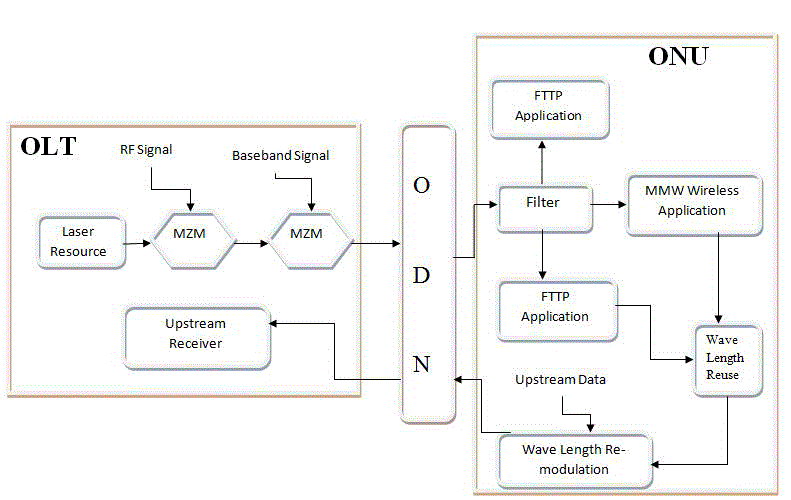 |
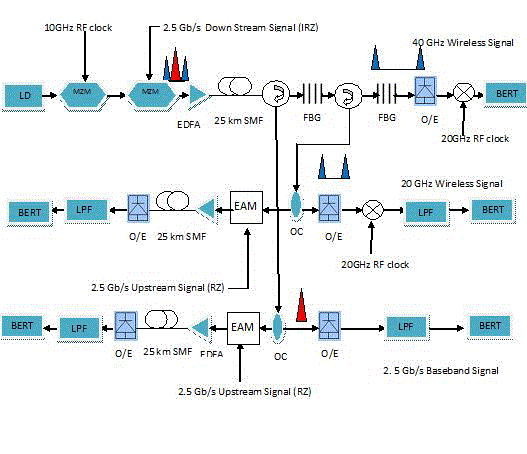 |
 |
| Figure 1 |
Figure 2 |
Figure 3 |
|
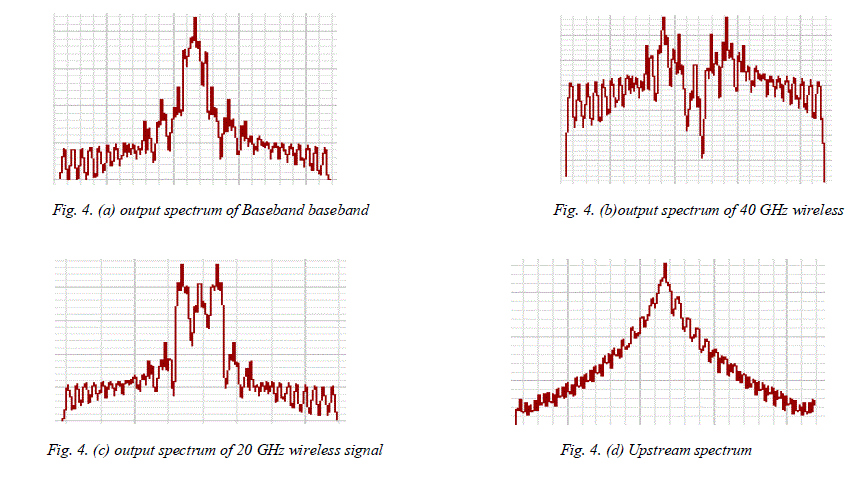 |
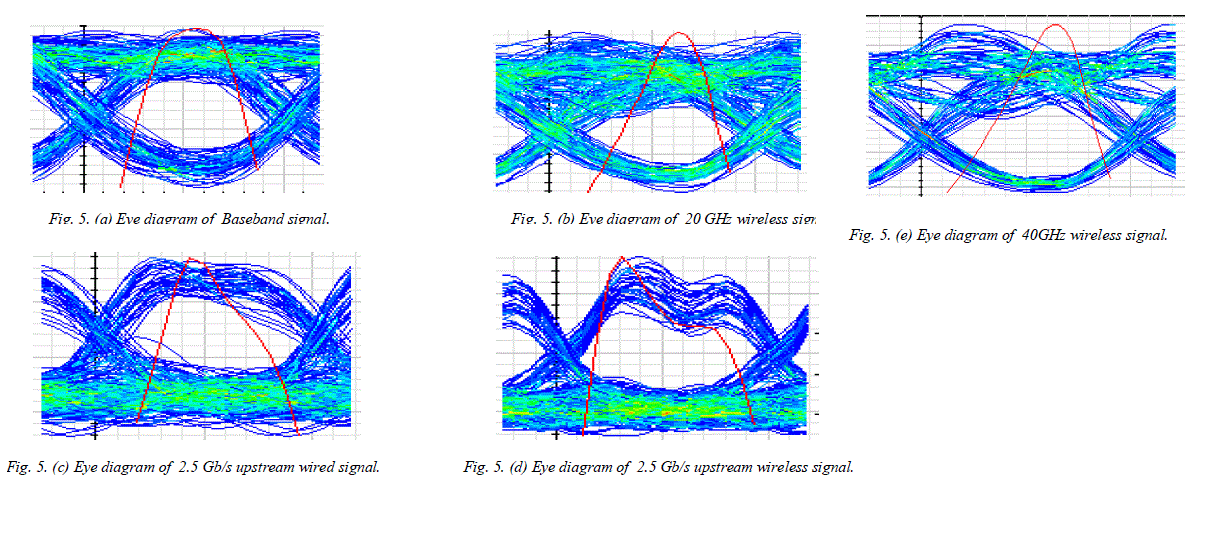 |
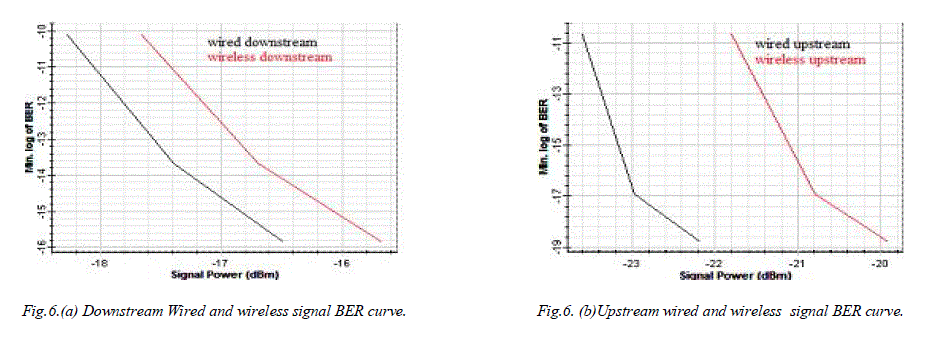 |
| Figure 4 |
Figure 5 |
Figure 6 |
|
References
|
- ZhenboXu and Yan Zhou ,’Multi frequency All-optical up conversion without cross talk in a Radio-Over-Fiber system by using an I/OModulato’ J. Opt.Net., vol. 2, NO. 4.,pp.1943-0620.Apr. 2010.
- Chun-Ting Lin, Jason (Jyehong) Chen, Peng-Chun Peng, Cheng FengPeng, Wei-RenPeng, Bi-ShiouChiou, and Sien Chi, ‘Hybrid OpticalAccess Network Integrating Fiber-to-the-Home and Radio-Over-Fiber Systems’ IEEE Photon. Technol. Lett., vol. 19, no. 8,April 15,2007.
- J. Yu, Z. Jia, L. Yi, G. K. Chang, and T. Wang, ‘Optical millimeter- wave generation or up-conversion using external modulator,’ IEEE Photon.Technol. Lett., vol. 18, no. 1, pp. 265–267, Jan. 1, 2006.
- L. G. Kazovsky, W.-T.Shaw, D. Gutierrez, N. Cheng, and S.-W. Wong, ‘Next-generation optical access networks,’ J. Light wave Technol.,vol. 25, no. 11, pp. 3428–3442,Nov. 2007.
- Wei Ji and Zhaoyuan Kang, ‘Design of WDM RoF PON Based on OFDM and Optical Heterodyne’ J. Opt. Netw,. vol. 5, no. 6.,pp.1943- 0620.,JUNE 2013.
- H. D. Kim, S.-G. Kang, and C.-H. Lee, ‘A low-cost WDM source with an ASE injected Fabry-Perot semiconductor laser,’ IEEE Photon Technol. Lett., vol. 12, no. 8, pp. 1067–1069, Aug. 2000.
- P. Healey, P. Townsend, C. Ford, L. Johnston, P. Townley, I. Lealman, L. Rivers, S. Perrin, and R. Moore, ‘Spectral slicing WDM-PONusing wavelength-seeded reflective SOAs,’ Electron. Lett., vol. 37, no. 19, pp. 1181–1182, Sept. 2001.
- Marco Presi, Roberto Prietti, Kamau Prince, GiampieroContestabile, and Ernesto Ciaramella, ‘A 80 km reach fully passive WDM-PON based on reflective ONUs’ OPTICAL Express 19043 Vol.16,No.23/ 10 November 2008.
- Z. Dong, J. Lu, Z. Cao, and L.Chen, ‘Low-cost optical line terminal for a WDM-PON compatible with radio-over-fiber systems’ J. Opt.Netw., vol. 8,no 3,pp.244-248,Mar.2009.
- J.Yu, O.Akanbi, Y.Luo, L.Zong, T.Wang, Z.Jia ,and G.K Chang, ‘Demonstration of noval WDM passive optical network architecture with source free optical network units,’ IEEE Photon Technol. Lett., vol. 19, no. 8, pp. 571-573, April. 2007.
- N. Calabretta, M. Presi, R. Proietti, G. Contestabile, and E. Ciaramella, ‘A. Bidirectional WDM/TDM-PON using DPSK DownstreamSignals and Narrowband AWG,’ IEEE Photon. ehcnol.Lett.19.1227-1229(2007).
- Y. Y. WON , H. S. kim, Y.H. Son, and S.K. Han, ‘Full colorless WDM-radio over fiber access network supporting simultaneous transmission of millimeter-wave band and baseband gigabit signals by sideband routing,’ J. Lightw.Technol.,vol.28, pp.2213-2218, Aug.2010.
|